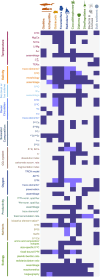The Micropaleoecology Framework: Evaluating Biotic Responses to Global Change Through Paleoproxy, Microfossil, and Ecological Data Integration
- PMID: 39493613
- PMCID: PMC11525056
- DOI: 10.1002/ece3.70470
The Micropaleoecology Framework: Evaluating Biotic Responses to Global Change Through Paleoproxy, Microfossil, and Ecological Data Integration
Abstract
The microfossil record contains abundant, diverse, and well-preserved fossils spanning multiple trophic levels from primary producers to apex predators. In addition, microfossils often constitute and are preserved in high abundances alongside continuous high-resolution geochemical proxy records. These characteristics mean that microfossils can provide valuable context for understanding the modern climate and biodiversity crises by allowing for the interrogation of spatiotemporal scales well beyond what is available in neo-ecological research. Here, we formalize a research framework of "micropaleoecology," which builds on a holistic understanding of global change from the environment to ecosystem level. Location: Global. Time period: Neoproterozoic-Phanerozoic. Taxa studied: Fossilizing organisms/molecules. Our framework seeks to integrate geochemical proxy records with microfossil records and metrics, and draws on mechanistic models and systems-level statistical analyses to integrate disparate records. Using multiple proxies and mechanistic mathematical frameworks extends analysis beyond traditional correlation-based studies of paleoecological associations and builds a greater understanding of past ecosystem dynamics. The goal of micropaleoecology is to investigate how environmental changes impact the component and emergent properties of ecosystems through the integration of multi-trophic level body fossil records (primarily using microfossils, and incorporating additional macrofossil data where possible) with contemporaneous environmental (biogeochemical, geochemical, and sedimentological) records. Micropaleoecology, with its focus on integrating ecological metrics within the context of paleontological records, facilitates a deeper understanding of the response of ecosystems across time and space to better prepare for a future Earth under threat from anthropogenic climate change.
Keywords: IODP; biogeochemistry; biomarkers; climate change; conservation paleobiology; ecosystems; microfossils; oceanography; paleoceanography; paleontology.
© 2024 The Author(s). Ecology and Evolution published by John Wiley & Sons Ltd.
Conflict of interest statement
The authors declare no conflicts of interest.
Figures



References
-
- Adams, J. A. , and Gasparini P.. 1970. Gamma‐Ray Spectrometry of Rocks. Amsterdam: Elsevier.
-
- Alvarez, S. A. , Gibbs S. J., Bown P. R., Kim H., Sheward R. M., and Ridgwell A.. 2019. “Diversity Decoupled from Ecosystem Function and Resilience During Mass Extinction Recovery.” Nature 574, no. 7777: 242–245. - PubMed
-
- Altabet, M. , and Francois R.. 1994. “The Use of Nitrogen Isotopic Ratio for Reconstruction of Past Changes in Surface Ocean Nutrient Utilization.” Carbon Cycling in the Glacial Ocean: Constraints on the Ocean's Role in Global Change: NATO ASI Series 17: 281–306. 10.1007/978-3-642-78737-9_12. - DOI
-
- Armstrong, H. , and Brasier M.. 2013. Microfossils. Oxford, UK: Blackwell Publishing.
Publication types
LinkOut - more resources
Full Text Sources
Miscellaneous

